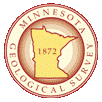
Judging from the surface, one might say Anoka County’s geology is simple: ‘its just sand.’ But, beneath the flat sandy surface is a complex arrangement of glacial deposits (e.g. peat, sand, gravel and clay) over equally complex formations of bedrock (e.g. shale, sandstone and dolomite) that can’t be seen. The completed Geologic Atlas of Anoka County helps to reveal what’s under the surface.

QUATERNARY STRATIGRAPHY (PLATE 4) One of 87 west-to-east geologic cross-sections (Ramsey-Andover-Ham Lake-Columbus) of the glacial deposits that vary widely and fill bedrock valleys with sand, gravel, clay and other loose materials.
Nine (9) bedrock formations have been identified in which some are groundwater aquifers and others (aquitards) do not provide water to a well. And, some formations – including the Prairie du Chien – Jordan (PDC-JDN) aquifer – are found only in the southern (Fridley and Spring Lake Park) and south-eastern (Blaine and Lino Lakes) parts of Anoka County. The bedrock formations have undergone erosion by glaciers that have created the complex valleys shown in the Atlas.

BEDROCK TOPOGRAPHY (PLATE 6). The thickness of glacial sediments is equal to the depth of land surface elevation to bedrock surface elevation. The tan and yellow areas indicate shallow depth to bedrock. Blue and purple areas indicate greater depths and bedrock valleys.
The Geologic Atlas is more than just detailed maps of subsurface geologic materials and formations in Anoka County. Part B (hydrogeology) provides information and analysis of the groundwater resources that are found within the geologic formations beneath the County. Part B helps to answer questions such as: what amounts of water are found in the geologic formations; how sustainable are groundwater resources to to provide for increasing demand; where the water is moving; the sensitivity of groundwater aquifers to pollution and how vulnerable are local drinking water wells to pollution.
This six-year project to create the Anoka County Geologic Atlas is nearing completion. Part A (geologic maps) were prepared by the Minnesota Geologic Survey. Part B (hydrogeologic maps and report), by the Minnesota Department of Natural Resources, are undergoing final review.
For more information contact Jamie Schurbon (763/434-2030 ext. 12, Email) at the Anoka Conservation District.



 December 7th, 2016
December 7th, 2016  knowtheflow
knowtheflow 
 Posted in
Posted in